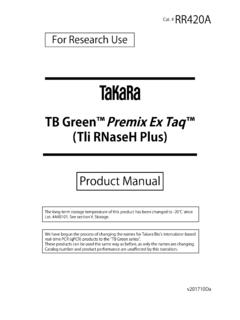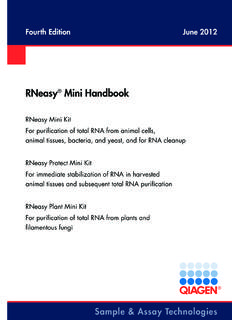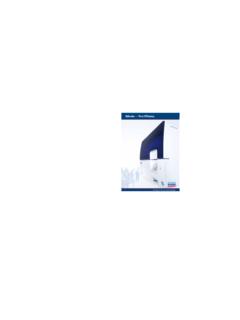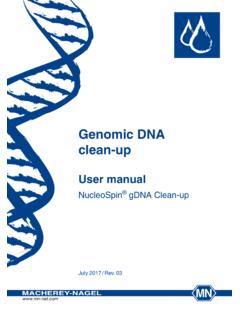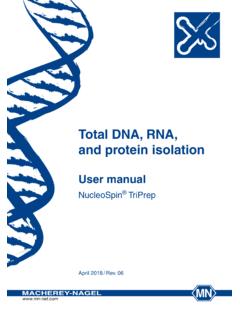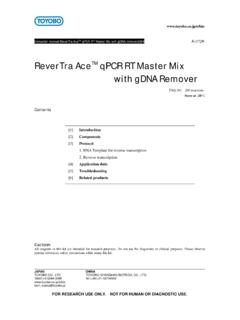Transcription of RNAiso Plus (Total RNA extraction reagent) - TaKaRa
1 Cat. # 9108/9109 Product ManualRNAiso plus (Total RNA extraction reagent) For Research Usev201301Da2 RNAiso plus ( total RNA extraction reagent )Cat. #9108/9109v201301 DaURL: DescriptionRNAiso plus is a total RNA extraction reagent which can isolate RNA easily and rapidly from animal or plant tissues and cultured cells. After homogenizing the tissues or cells in the RNAiso plus solution, add chloroform to the homogenate solution, mixed well, and then centrifuge to separate the solution into three layers. The top layer will be a clear liquid containing RNA, the middle layer will be a semi-solid containing DNA, and the bottom layer will be a red colored organic solvent containing proteins, polysaccharides, fatty acid, cell debris, and small amount of DNA.
2 Remove the top liquid layer and pipet into a new tube. Be careful not to remove any of the middle layer. Perform an isopropanol precipitation to extract the total RNA. Using the RNAiso plus , the total RNA extraction process can be done in about one hour. The isolated total RNA is intact and does not contain a small amount of DNA or proteins, thus it can be used for RT-PCR , Northern blot analysis, mRNA isolation, and in vitro translation reactions. If being used for RT-PCR, even an extremely small amount of genomic DNA could affect the result, so treat with Recombinant DNase I (RNase-free) (Cat.)
3 #2270A) before use. II ContentsRNAiso plus (Cat. #9108) 100 mlRNAiso plus (Cat. #9109) 200 ml Contains a protein denaturator, so avoid skin contact. If comes in contact with eyes or skin, wash with water immediately and seek for medical suggestion by a doctor. Materials required but not provided Chloroform Isopropanol 75% ethanol (prepared with DEPC-treated water) RNase-free waterIII Storage4 CStore in a dark place to retain plus ( total RNA extraction reagent )Cat. #9108/9109v201301 DaURL: General instructions for handling RNA 1 Sterilized disposable plastic equipments are RNase free in general, thus they can be used for this experiment.
4 Use only autoclaved microcentrifuge tubes or tips for micropipette for this experiment. When using glass equipment or spatulas, perform dry heat sterilization at 160 C for two hours. Equipment which cannot do dry heat sterilized should be treated with diethylpyrocarbonate (DEPC) solution at 37 C for twelve hours then autoclaved (prevent RNA carboxymethylation with DEPC).Note Be sure to discriminate the equipment for RNA Try to make most of the reagents with DEPC treated water. The reagents should be autoclaved before use.
5 If there is a reagent that cannot be autoclaved, use sterilized equipment and components to prepare the reagent, and sterile filtered before use. 3 Researcher s bare hands are the biggest cause of the RNase contamination. Be sure to use disposable plastic gloves and masks when handling experiment reagents associated with Protocol 1 Required Amount of RNAiso plus for extraction Sample types and amountsRNAiso plus amount (ml)Adherent cells on 10 cm2 petri dish1 - 25 x 106 - 1 x 107 of non-adherent cells1100 l of white blood cells250 - 100 mg of tissue sample Tissue which RNA can be easily extract Tissue which RNA can be difficult to extract (liver, spleen, born, and cartilage 1)
6 1215 - 30 mg of plant material 2 (containing small amount of polysaccharide and phenol)12 - 5 x 107 yeast cells 3 1 1: For RNA extraction from bone and cartilage, it is recommended to use High-Salt Solution for Precipitation (Plant) (Cat. #9193) in combination with RNAiso plus . 2: For RNA extraction from plant samples that contain large amount of polysaccharides, it is recommended to use Fruit-mate for RNA Purification (Cat. #9192) as a pretreatment reagent in combination with RNAiso plus . 3: For RNA extraction from yeast, use Yeast Processing Reagent (for total RNA preparation) (Cat.)
7 #9089) as a pretreatment reagent in combination with RNAiso plus ( total RNA extraction reagent )Cat. #9108/9109v201301 DaURL: ReagentsA Adherent cells1 ) Aspirate off media and wash with 1X PBS, enough to just cover the ) Add 1 - 2 ml of RNAiso plus onto a 10 cm2 petri dish of adherent cells, swirl the reagent around in plate to make sure the surface has been covered with If the cells are difficult to remove, use a cell ) Collect the cells with a pipette and transfer them to the centrifuge tube.
8 Repeatedly pipette several times until cells are completely resuspended. 4 ) Leave the samples at room temperature (15 - 30 C) for 5 minutes, then isolate the RNA from nuclear protein. B Non-adherent cells1 ) Collect and pipette the cells and media into a centrifuge tube. Centrifuge the tube at 8,000X g for 2 minutes at 4 C. Discard supernatant and be care not to disturb the cell pellet. 2 ) Add 1 ml of RNAiso plus for every 5 x 106 cells. 3 ) Pipette up and down until pellet is completely resuspended.
9 4 ) Leave at room temperature (15 - 30 C) for 5 minutes, isolate the RNA from the nuclear Animal and plant tissue sample1 ) Immediately transfer frozen tissue into mortar, add liquid nitrogen, then crush with pestle to homogenize until powdery. (if it is not homogenized into small particles, it may affect RNA quality or the yield amount.) Add an amount of RNAiso plus to correspond with the amount of tissue that was homogenized. For a fresh tissue sample, add RNAiso plus immediately after collecting the tissue, and homogenize completely.
10 2 ) Transfer homogenized sample into a centrifuge tube, keep at the room temperature (15 - 30 C) for 5 minutes. 3 ) Centrifuge the tube at 12,000X g for 5 minutes at 4 C. 4 ) Collect supernatant and transfer it to a new centrifuge tube (do not collect pellet).3 extraction of total RNA1 ) To the solution from above, ml of chloroform per 1 ml of RNAiso plus used for homogenization. Cap the centrifuge tube and mix until the solution becomes ) Keep the solution at room temperature for 5 ) Centrifuge at 12,000X g for 15 minutes at 4 C.

